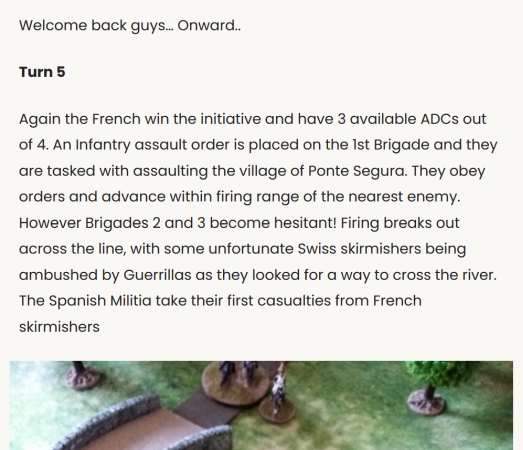Renowned sculptor Tony Barton continues to expand and embellish his benchmark range of 15mm Napoleonic miniatures with new figures to represent the regiments of Napoleon's Young Guard. Collectors who have patiently waited for these figures can now raise Young Guard formations for any of the campaigns they served in - from their creation in 1809, to their demise and re-birth in 1812-13, to their superhuman exertions of the doomed 1814 campaign to defend Paris.

Napoleon's Imperial Guard is arguably the most famous corps of the Napoleonic Wars. Founded originally as a small escort for the members of the Revolutionary government's Directory, it expanded into Bonaparte's personal 'Consular Guard' in 1799-1800, composed of many army veterans whose first allegiance was to Napoleon, and no other member of the French government! When Napoleon declared himself Emperor in 1804, the Consular Guard became the Imperial Guard, and continued to expand into an army in its own right, existing almost independently within the rest of the French army. By 1812 it had reached some 56,000 men, and in the later campaigns of 1813-14, as it became Napoleon's 'fire brigade' and bore the brunt of the fighting, it almost doubled in size again.
Napoleon's Guard can sometimes be a confusing military institution to contemplate, as it underwent several major reorganizations as part of its relentless expansion. The first regiments of what was to become known as the Young Guard were raised in 1809, mostly from young conscripts augmented with cadres of experienced guardsmen and selected drafts from Line units. This constant transferal of personnel between units in order to mix inexperienced newcomers with a core of hard-boiled veterans was a principal feature of the way the Guard functioned and developed its soldiers. As such, the Young Guard might be seen as a kind of recruit 'nursery' for the rest of the Guard, but its apparent junior status within the Guard should in no way detract from its regiments' formidable fighting abilities in their own right.
The first Young Guard regiment to be formed was the Tirailleurs of the Guard in January 1809, soon to be restyled as the Tirailleurs-Grenadiers to differentiate them from the newly raised Tirailleurs-Chasseurs. These were rapidly joined by two regiments each of Conscrit-Grenadiers and Conscrit-Chasseurs, and then second regiments of Tirailleurs-Grenadiers and Tirailleurs-Chasseurs were also added - all within the space of five months. These regiments first saw action at the Battle of Aspern-Essling, and later in the year many were sent to serve in the Spanish campaign. All were essentially equipped and uniformed in the same way - as light infantry, and the first five codes in this release (IG55 - 58) should allow the recreation in miniature of any of these units. In December 1810, the two regiments of Tirailleurs-Chasseurs became 1st and 2nd Voltigeurs of the Guard (while the Tirailleurs-Grenadiers simply reverted to the 1st and 2nd Tirailleurs). Further Voltigeur regiments were added in 1811 by converting the two Conscrit-Chasseur regiments into the 3rd and 4th Voltigeurs of the Guard (while the Conscrit-Grenadiers now became the 3rd and 4th Tirailleurs). Brand-new formations were then raised to create 5th and 6th Regiments of both Voltigeurs and Tirailleurs. The appearance of the Tirailleur regiments remained largely unaltered, but Voltigeur regiments were assigned new uniforms with epaulettes to distinguish them from their brethren in the Tirailleurs. Codes IG60-64 are designed to represent the Voltigeurs of the Guard.
The deprivations of the Russian campaign in 1812 all but destroyed the Young Guard, but Napoleon somehow managed to rebuild it in 1813 from conscripts and Line veterans - even managing to enlarge it with many new regiments of Tirailleurs and Voltigeurs. It bore much of the fighting in 1813-14 and performed (as Napoleon himself put it) "miracles" against increasingly impossible odds. During this period the regiments of the Young Guard were instructed to change to the habit-veste jacket of 1812 with its shorter tails, squarer lapels - closed to the waist. This final version of the uniform (represented in our release by codes IG65-69) was worn by most, if not all, regiments by 1814, including the Voltigeurs (who had now abandoned their showy epaulettes).
Those of you familiar with Tony Barton's work will know that despite their small size, these figures are finely detailed and realistically proportioned to a standard that still makes AB Figures the definitive range of Napoleonic miniatures in this scale. As with all AB and Eureka figures, aside from a few sets, you can order these miniatures in any quantity you wish - large or small. Customers are not restricted to bulky multi-figure packs which force them to pay for figures they do not need.

Here are the catalogue details for the new miniatures:
NEW 15mm AB Figures - French Young Guard
Sculpted by Tony Barton
IG55 - Young Guard, 1809-12 uniform, at attention
IG56 - Young Guard, 1809-12 uniform, skirmishing
IG57 - Young Guard Drummer, 1809-12 uniform
IG58 - Young Guard Officer, 1809-12 uniform
IG59 - Young Guard Standard Bearer, 1809-12 uniform
IG60 - Young Guard Voltigeur, 1810 uniform, at attention
IG61 - Young Guard Voltigeur, 1810 uniform, skirmishing
IG62 - Young Guard Voltigeur Drummer, 1810 uniform
IG63 - Young Guard Voltigeur Officer, 1810 uniform
IG64 - Young Guard Voltigeur Standard Bearer, 1810 uniform
IG65 - Young Guard, 1814 uniform, marching
IG66 - Young Guard, 1814 uniform, skirmishing
IG67 - Young Guard Drummer, 1814 uniform
IG68 - Young Guard Officer, 1814 uniform
IG69 - Young Guard Standard Bearer, 1814 uniform
You can also order our new Young Guard in the U.K. from Fighting 15s, and in the U.S.A. from Eureka Miniatures U.S.A.







